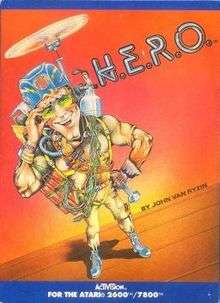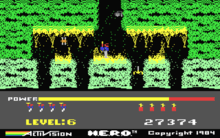H.E.R.O.
| H.E.R.O. | |
|---|---|
 Atari 2600 cover art | |
| Developer(s) | Activision |
| Publisher(s) | Activision |
| Designer(s) | John Van Ryzin[1] |
| Platform(s) |
Atari 2600 (original) Apple II, Atari 5200, Atari 8-bit, ColecoVision, Commodore 64, MSX, Sega SG-1000, ZX Spectrum |
| Release | |
| Genre(s) | Action game |
H.E.R.O. (standing for Helicopter Emergency Rescue Operation) is a video game written by John Van Ryzin[1] and published by Activision for the Atari 2600 in March 1984.[2] It was ported to the Apple II, Atari 5200, Atari 8-bit family, ColecoVision, Commodore 64, MSX, and ZX Spectrum. Sega released a version of the game for its SG-1000 console in Japan in 1985. While the gameplay was identical, Sega changed the backpack from a helicopter to a jetpack.[3]
The player uses a helicopter backpack and other tools to rescue victims trapped deep in a mine. The mine is made up of multiple screens using a flip screen style.
Gameplay


The player assumes control of Roderick Hero (sometimes styled as "R. Hero"), a one-man rescue team. Miners working in Mount Leone[4] are trapped, and it's up to Roderick to reach them.
The player is equipped with a backpack-mounted helicopter unit, which allows him to hover and fly, along with a helmet-mounted laser and a limited supply of dynamite. Each level consists of a maze of mine shafts that Roderick must safely navigate in order to reach the miner trapped at the bottom. The backpack has a limited amount of power, so the player must reach the miner before the power supply is exhausted.
Mine shafts may be blocked by cave-ins or magma, which require dynamite to clear. The helmet laser can also destroy cave-ins, but more slowly than dynamite. Unlike a cave-in, magma is lethal when touched. Later levels include walls of magma with openings that alternate between open and closed requiring skillful navigation. The mine shafts are populated by spiders, bats and other unknown creatures that are deadly to the touch; these creatures can be destroyed using the laser or dynamite.
Some deep mines are flooded, forcing players to hover safely above the water. In later levels, monsters strike out from below the water. Some mine sections are illuminated by lanterns. If the lantern is somehow destroyed, the layout of that section becomes invisible. Exploding dynamite lights up the mine for a brief time.
Points are scored for each cave-in cleared and each creature destroyed. When the player reaches the miner, points are awarded for the rescue, along with the amount of power remaining in the backpack and for each remaining stick of dynamite. Extra lives are awarded for every 20,000 points scored.
Reception
| Reception | ||||||
|---|---|---|---|---|---|---|
| ||||||
In the June 1987 issue of Zzap!64, Julian Rignall wrote, "HERO looks awful, sounds terrible but plays absolutely beautifully."[5]
Legacy

H.E.R.O. has been included in compilations of Activision games released for later-generation gaming consoles, such as Activision Anthology.
In 1985, ANALOG Computing published a clone called R.O.T.O. for the Atari 8-bit family.[6]
References
- 1 2 Hague, James. "The Giant List of Classic Game Programmers". dadgum.com.
- ↑ "H.E.R.O. for Atari 2600". GameFAQs.com. Retrieved 2010-06-25.
- ↑ "H.E.R.O. for SG-1000". GameFAQs.com. Retrieved 2010-06-25.
- ↑ "Atari 2600 Manuals - H.E.R.O. (Activision)". AtariAge.com. Retrieved 2010-06-25.
- 1 2 "HERO Review". Zzap!64 (26). June 1987.
- ↑ Stortz, Mike (June 1985). "R.O.T.O." ANALOG Computing (31): 25.
External links
- H.E.R.O. for the Atari 2600 at Atari Mania
- H.E.R.O for the Atari 8-bit family at Atari Mania
- H.E.R.O. at Lemon 64
- H.E.R.O. at SpectrumComputing.co.uk
- The Atari 2600 version of H.E.R.O. can be played for free in the browser at the Internet Archive